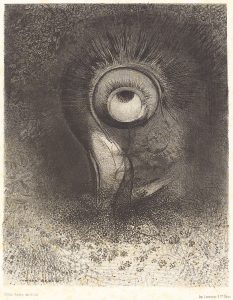
Art Appreciation – June/July 2023
 At the June meeting, Lynne gave a presentation on the French artist Odilon Redon (1840-1916). Lynne told us how she first became interested in Redon when she was studying art at college. While on a tour of European galleries, she saw his painting, Chariot of Apollo, and was very taken by Redon’s use of vivid colour and striking imagery. When she had committed to writing her dissertation on Redon and started her research, she was rather surprised to find that in contrast to the painting she had first encountered, much of his work was monochrome and the imagery was somewhat disturbing.
At the June meeting, Lynne gave a presentation on the French artist Odilon Redon (1840-1916). Lynne told us how she first became interested in Redon when she was studying art at college. While on a tour of European galleries, she saw his painting, Chariot of Apollo, and was very taken by Redon’s use of vivid colour and striking imagery. When she had committed to writing her dissertation on Redon and started her research, she was rather surprised to find that in contrast to the painting she had first encountered, much of his work was monochrome and the imagery was somewhat disturbing.
In his early career, Redon focused on charcoal drawings and lithographs. His early work is characterised by images such as disembodied heads and eyes masquerading as unlikely objects such as hot air balloons. He had a keen interest in the natural world, and many of his works show strange hybrid creatures – part plant, part human. It is no great surprise to find that later surrealist artists were influenced by his work.
He developed his use of colour in the 1870s and beyond, and his work moved into very new directions. In addition to painting in oils, Redon also used pastel to great effect, appreciating its immediacy and intensity of colour, qualities it shares with the charcoal of his earlier works. He was a founder member of the Salon des Indépendants, and exhibited alongside the impressionists such as Monet and Renoir, and also with Gaugin. Much of his work was inspired by literature and he had a close association with the poet Stéphane Mallarmé and others in the Symbolist movement. Greek and Roman mythology, portraits and religious subjects were frequent subjects for his works, , he also produced pictures of flowers and the natural world. In his later career, much of his work was purely decorative; for example, he was commissioned to produce large decorative panels for the Chateau Domecy and other notable buildings.
Redon had a very considerable reputation in his own lifetime, and was awarded the Légion d’honneur, the highest award for merit in French society. Despite this acclaim, his work is not as well known today as a number of his contemporaries so Lynne’s presentation may have inspired members to find out more.
The next meeting will be on Tuesday 11th July when members are invited to select and talk briefly about a work of art on the theme of ‘Water’. As ever, it will be interesting to see what members select.
John Vick
